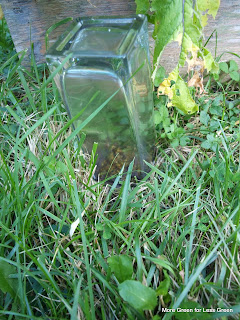Me Versus the Yellowjackets
Our front garden is a haven for pollinators this summer, and we are thrilled! In early July, though, we noticed an influx of yellow jackets. I wasn't too fazed until one day I noticed dozens of them clustered near the path to our front door.
Upon closer inspection, I realized that they were zipping in and out of a hole in the ground. As I searched for information, I learned that yellow jackets have underground hives (sometimes huge ones), they can sting victims repeatedly, and they get more aggressive as the summer wanes. In other words--we were in trouble. How could we get rid of these creatures without spending loads of money and keeping green?
On the internet, the most popular suggestion was to pour gasoline into the hole. No way! Keeping our lawn a chemical-free play zone was key. This method is illegal, dangerous, and can have long-term consequences for the ground and its inhabitants. Rigging hornet spray on to a pole and putting that into the hole was another common suggestion. That seemed complicated, dangerous, and we were worried about what that would do to our lovely organic veggies.
Ultimately, we decided that capping the hole with a glass vessel would be the easiest, safest, and cheapest tactic. The theory is that no wasps get in our out so the colony starves plus the glass creates a killer hotbox. But, would it work? Since the yellow jackets were able to dig a hole to make the nest in the first place, wouldn't they just dig new holes and ditch the capped one? We had nothing to lose, so it was worth a try.
I waited until after dark one night to put a mason jar cap over the hole. Since yellow jackets go in the ground for the night, I could get close without much fear of being stung. The next day, yellow jackets emerged from the hole but couldn't get out. They flew around inside the jar, contained.
By the second day, though, they dug their hole wider than the jar and a few managed to get in and out through the gap. I needed a bigger jar. In the dark, once again, I swapped out my containers. A thick, glass flower vase fit the bill.
As I worked, I noticed several new holes had popped up in the yard. Interestingly, it looked like the escapees were digging down versus the trapped yellow jackets digging out. I put some jars on top of those, too.
After about a week of nothing, more yellow jackets emerged. We suspect that the adults died out the first week and the second wave was babies that survived the famine as egg. With the vase still in place, they were all gone again after a day or two.
It has now been two weeks with no sightings. At one point, we talked about going out after dark one night, covered head-to-toe in thick clothing, to dump boiling water down the hole to eliminate any remaining life, but we think we are in the clear now.
 |
| Remnants of the yellow jacket hole |










